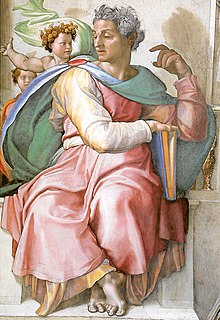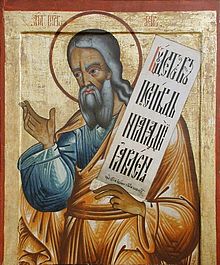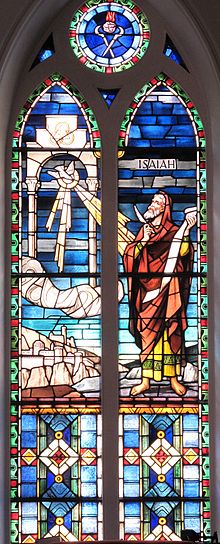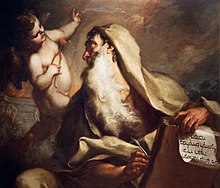Isaiah
Isaiah | |
|---|---|
 Fresco from the Sistine Chapel ceiling by Michelangelo | |
| Prophet | |
| Born | 8th century BC |
| Died | 7th century BC |
| Venerated in | Judaism Christianity Islam[1] |
| Feast | May 9[2] Thursday after the Feast of the Transfiguration (Armenian Apostolic Church)[3] |
| Major works | Book of Isaiah |
Isaiah (UK: /aɪˈzaɪ.ə/ or US: /aɪˈzeɪ.ə/;[4][5] Hebrew: יְשַׁעְיָהוּ, Yəšaʿyāhū, "Yahweh is salvation";[6] also known as Isaias[7] or Esaias[8] from Greek: Ἠσαΐας) was the 8th-century BC Israelite prophet after whom the Book of Isaiah is named.[9][10]
The text of the Book of Isaiah refers to Isaiah as "the prophet",[11] but the exact relationship between the Book of Isaiah and the actual prophet Isaiah is complicated. The traditional view is that all 66 chapters of the book of Isaiah were written by one man, Isaiah, possibly in two periods between 740 BC and c. 686 BC, separated by approximately 15 years.
Another widely held view suggests that parts of the first half of the book (chapters 1–39) originated with the historical prophet, interspersed with prose commentaries written in the time of King Josiah 100 years later, and that the remainder of the book dates from immediately before and immediately after the end of the 6th-century BC exile in Babylon (almost two centuries after the time of the historical prophet), and that perhaps these later chapters represent the work of an ongoing school of prophets who prophesied in accordance with his prophecies.[a]
Biography
[edit]
The first verse of the Book of Isaiah states that Isaiah prophesied during the reigns of Uzziah (or Azariah), Jotham, Ahaz, and Hezekiah, the kings of Judah.[12] Uzziah's reign was 52 years in the middle of the 8th century BC, and Isaiah must have begun his ministry a few years before Uzziah's death, probably in the 740s BC. He may have been contemporary for some years with Manasseh. Thus, Isaiah may have prophesied for as long as 64 years.[13]
According to some modern interpretations, Isaiah's wife was called "the prophetess",[14] either because she was endowed with the prophetic gift, like Deborah[15] and Huldah,[16] or simply because she was the "wife of the prophet".[13][17] They had two sons, naming the elder Shear-Jashub, meaning "A remnant shall return",[18] and the younger Maher-Shalal-Hash-Baz, meaning, "Quickly to spoils, plunder speedily."[19]

Soon after this, Shalmaneser V determined to subdue the northern Kingdom of Israel, taking over and destroying Samaria and beginning the Assyrian captivity. So long as Ahaz reigned, the kingdom of Judah was untouched by the Assyrian power. But when Hezekiah gained the throne, he was encouraged to rebel "against the king of Assyria",[20] and entered into an alliance with the king of Egypt.[21] The king of Assyria threatened the king of Judah, and at length invaded the land. Sennacherib's campaign in the Levant brought his powerful army into Judah. Hezekiah was reduced to despair, and submitted to the Assyrians.[22] But after a brief interval, war broke out again. Again Sennacherib led an army into Judah, one detachment of which threatened Jerusalem.[23] Isaiah on that occasion encouraged Hezekiah to resist the Assyrians,[24] whereupon Sennacherib sent a threatening letter to Hezekiah, which he "spread before the LORD".[25][13]
Then Isaiah son of Amoz sent this message to Hezekiah: "Thus said GOD, the God of Israel, to whom you have prayed, concerning King Sennacherib of Assyria—
this is the word that GOD has spoken concerning him: Fair Maiden Zion despises you, She mocks at you; Fair Jerusalem shakes Her head at you. Whom have you blasphemed and reviled? Against whom made loud your voice And haughtily raised your eyes?
Against the Holy One of Israel![26]
According to the account in 2 Kings 19 (and its derivative account in 2 Chronicles 32) an angel of God fell on the Assyrian army and 185,000 of its men were killed in one night. "Like Xerxes in Greece, Sennacherib never recovered from the shock of the disaster in Judah. He made no more expeditions against either Judea or Egypt."[13][27]
The remaining years of Hezekiah's reign were peaceful. Isaiah probably lived to its close, and possibly into the reign of Manasseh. The time and manner of his death are not specified in either the Bible or other primary sources.[13] The Talmud says that he suffered martyrdom by being sawn in two under the orders of Manasseh.[28]
The book of Isaiah, along with the book of Jeremiah, is distinctive in the Hebrew bible for its direct portrayal of the "wrath of the LORD" as presented, for example, in Isaiah 9:19 stating "Through the wrath of the LORD of hosts is the land darkened, and the people shall be as the fuel of the fire."[29]
In Christianity
[edit]
The Ascension of Isaiah, a pseudepigraphical Christian text dated to sometime between the end of the 1st century and the beginning of the 3rd, gives a detailed story of Isaiah confronting an evil false prophet and ending with Isaiah being martyred – none of which is attested in the original Biblical account.
Gregory of Nyssa (c. 335–395) believed that the Prophet Isaiah "knew more perfectly than all others the mystery of the religion of the Gospel". Jerome (c. 342–420) also lauds the Prophet Isaiah, saying "He was more of an Evangelist than a Prophet, because he described all of the Mysteries of the Church of Christ so vividly that you would assume he was not prophesying about the future, but rather was composing a history of past events."[30] Of specific note are the songs of the Suffering Servant, which Christians say are a direct prophetic revelation of the nature, purpose, and detail of the death of Jesus Christ.
The Book of Isaiah is quoted many times by New Testament writers.[31] The Gospel of John says that Isaiah "saw Jesus' glory and spoke about him."[32]
The Eastern Orthodox Church celebrates Saint Isaiah the Prophet with Saint Christopher on May 9.[33] Isaiah is also listed on the page of saints for May 9 in the Roman martyrology of the Roman Catholic Church.[34]
The Book of Mormon quotes Jesus Christ as stating that "great are the words of Isaiah", and that all things prophesied by Isaiah have been and will be fulfilled.[35] The Book of Mormon and Doctrine and Covenants also quote Isaiah more than any other prophet from the Old Testament.[36] Additionally, members of the Church of Jesus Christ of Latter-day Saints consider the founding of the church by Joseph Smith in the 19th century to be a fulfillment of Isaiah 11, the translation of the Book of Mormon to be a fulfillment of Isaiah 29,[37] and the building of Latter-day Saint temples as a fulfillment of Isaiah 2:2.[38]
In Islam
[edit]Isaiah (Arabic: إِشَعْيَاء, romanized: Ishaʿyāʾ) is not mentioned by name in the Quran or the Hadith, but appears frequently as a prophet in Muslim sources such as the qiṣaṣ al-anbiyāʾ and various tafsirs.[39] Al-Tabari (310/923) provides the typical accounts for Islamic traditions regarding Isaiah.[40] He is listed among the prophets in the book of salawat Dalail al-Khayrat. He is further mentioned and accepted as a prophet by other Islamic scholars such as ibn Kathir, Abu Ishaq al-Tha'labi and al-Kisa'i and also modern scholars such as Muhammad Asad and Abdullah Yusuf Ali.[41]
According to Muslim scholars, Isaiah prophesied the coming of Jesus and Muhammad, although the claim is disputed by other religious scholars.[42] Isaiah's narrative in Islamic literature can be divided into three sections. The first establishes Isaiah as a prophet of Judea during the reign of Hezekiah; the second relates Isaiah's actions during the siege of Jerusalem in 597 BC by Sennacherib; and the third warns the nation of coming doom.[43][40] Paralleling the Hebrew Bible,[44] Islamic tradition states that Hezekiah was king in Jerusalem during Isaiah's time. Hezekiah heard and obeyed Isaiah's advice, but could not quell the turbulence in Israel.[45] This tradition maintains that Hezekiah was a righteous man and that the turbulence worsened after him. After the death of the king, Isaiah told the people not to forsake God, and warned Israel to cease from its persistent sin and disobedience. Muslim tradition maintains that the unrighteous of Judea in their anger sought to kill Isaiah.[45]
In a death that resembles that attributed to Isaiah in Lives of the Prophets, Muslim exegesis recounts that Isaiah was martyred by Israelites by being sawn asunder.[45][46]
In the courts of al-Ma'mun, the seventh Abbasid caliph, Ali al-Ridha, the great-grandson of Muhammad and prominent scholar of his era, was questioned by the Exilarch to prove through the Torah that both Jesus and Muhammad were prophets. Among his several proofs, al-Ridha references the Book of Isaiah, stating "Sha'ya (Isaiah), the Prophet, said in the Torah concerning what you and your companions say 'I have seen two riders to whom (He) illuminated earth. One of them was on a donkey and the other was on a camel. Who is the rider of the donkey, and who is the rider of the camel?'" The Exilarch was unable to answer with certainty. Al-Ridha goes on to state that "As for the rider of the donkey, he is 'Isa (Jesus); and as for the rider of the camel, he is Muhammad, may Allah bless him and his family. Do you deny that this (statement) is in the Torah?" The Rabbi responds "No, I do not deny it."[47]
In rabbinic literature
[edit]
Allusions in Jewish rabbinic literature to Isaiah contain various expansions, elaborations and inferences that go beyond what is presented in the text of the Bible.
Origin and calling
[edit]According to the ancient rabbis, Isaiah was a descendant of Judah and Tamar,[48] and his father Amoz was the brother of King Amaziah.[49]
While Isaiah, says the Midrash, was walking up and down in his study he heard God saying "Whom shall I send?" Then Isaiah said "Here am I; send me!" Thereupon God said to him," My children are troublesome and sensitive; if you are ready to be insulted and even beaten by them, you may accept My message; if not, you would better renounce it".[50] Isaiah accepted the mission, and was the most forbearing, as well as the most patriotic, among the prophets, always defending Israel and imploring forgiveness for its sins. When Isaiah said "I dwell in the midst of a people of unclean lips",[51] he was rebuked by God for speaking in such terms of His people.[52]
Further accounts state that Isaiah was actually the maternal grandfather of King Manasseh,[53] which would make Queen Consort Hephzibah from 2 Kings 21:1 his daughter and King Hezekiah his son-in-law. Hephzibah's name was used as a symbolic name for Zion following its restoration to the favor of Yahweh in Isaiah 62.[54]
His death
[edit]It is related in the Talmud that Rabbi Simeon ben Azzai found in Jerusalem an account wherein it was written that King Manasseh killed Isaiah. King Manasseh said to Isaiah "Moses, your master, said 'No man may see God and live';[55] but you have said 'I saw the Lord seated upon his throne'";[56] and went on to point out other contradictions—as between Deuteronomy[57] and Isaiah 40;[58] between Exodus 33[59] and 2 Kings[60] Isaiah thought: "I know that he will not accept my explanations; why should I increase his guilt?" He then uttered the tetragrammaton, a cedar-tree opened, and Isaiah disappeared within it. King Manasseh ordered the cedar to be sawn asunder, and when the saw reached his mouth Isaiah died; thus was he punished for having said "I dwell in the midst of a people of unclean lips".[61]
A somewhat different version of this legend is given in the Jerusalem Talmud.[62] According to that version Isaiah, fearing King Manasseh, hid himself in a cedar-tree, but his presence was betrayed by the fringes of his garment, and King Manasseh caused the tree to be sawn in half. A passage of the Targum to Isaiah quoted by Jolowicz[63] states that when Isaiah fled from his pursuers and took refuge in the tree, and the tree was sawn in half, the prophet's blood spurted forth. The legend of Isaiah's martyrdom spread to the Arabs[64] and to the Christians as, for example, Athanasius the bishop of Alexandria (c. 318) wrote, "Isaiah was sawn asunder".[65]
Archaeology
[edit]In February 2018, archaeologist Eilat Mazar announced that she and her team had discovered a small seal impression which reads "[belonging] to Isaiah nvy" (could be reconstructed and read as "[belonging] to Isaiah the prophet") during the Ophel excavations, just south of the Temple Mount in Jerusalem.[66] The tiny bulla was found "only 10 feet away" from where an intact bulla bearing the inscription "[belonging] to King Hezekiah of Judah" was discovered in 2015 by the same team.[67] Although the name "Isaiah" in the Paleo-Hebrew alphabet is unmistakable, the damage on the bottom left part of the seal causes difficulties in confirming the word "prophet" or a name "Navi", casting some doubts whether this seal really belongs to the prophet Isaiah.[68]
Notes
[edit]- ^ See the article "Book of Isaiah" for an extended overview of theories of its composition.
References
[edit]- ^ Historical Dictionary of Prophets in Islam and Judaism, B. M. Wheeler, Appendix II
- ^ St. John the Baptist Byzantine Catholic Cathedral, Holy Prophet Isaiah Archived 2017-06-27 at the Wayback Machine
- ^ "Holidays | Qahana.am". Archived from the original on 2022-02-01. Retrieved 2021-07-14.
- ^ Wells, John C. (1990). "Isaiah". Longman pronunciation dictionary. Harlow, England: Longman. p. 378. ISBN 978-0-582-05383-0.
- ^ Rippin, A., "S̲h̲aʿyā", in: Encyclopaedia of Islam, Second Edition, edited by: P. Bearman, Th. Bianquis, C. E. Bosworth, E. van Donzel, W. P. Heinrichs.
- ^ New Bible Dictionary, Second Edition, Tyndale Press, Wheaton, IL, 1987.
- ^ "CATHOLIC ENCYCLOPEDIA: Isaias". www.newadvent.org. Retrieved 2022-12-27.
- ^ "Bible Gateway passage: Luke 4:17-21 - King James Version". Bible Gateway. Retrieved 2023-04-29.
- ^ The Scofield Study Bible III, NKJV, Oxford University Press
- ^ De Jong, Matthijs J., Isaiah Among The Ancient Near Eastern Prophets: A Comparative Study of the Earliest Stages of the Isaiah Tradition and the Neo-Assyrian Prophecies, BRILL, 2007, pp. 13–17
- ^ Hebrew-English Bible, Isaiah 38:1
- ^ Hebrew-English Bible Isaiah 1:1
- ^ a b c d e
 One or more of the preceding sentences incorporates text from a publication now in the public domain: Easton, Matthew George (1897). "Isaiah". Easton's Bible Dictionary (New and revised ed.). T. Nelson and Sons.
One or more of the preceding sentences incorporates text from a publication now in the public domain: Easton, Matthew George (1897). "Isaiah". Easton's Bible Dictionary (New and revised ed.). T. Nelson and Sons.
- ^ Hebrew-English Bible, Isaiah 8:3
- ^ Hebrew-English Bible Judges 4:4
- ^ Hebrew-English Bible 2 Kings 22:14–20
- ^ Coogan, Michael D. A Brief Introduction to the Old Testament, Oxford University Press, 2009, p.273.
- ^ Hebrew-English Bible Isaiah 7:3
- ^ Hebrew-English Bible Isaiah 8:3
- ^ Hebrew-English Bible 2 Kings 18:7
- ^ Hebrew-English Bible Isaiah 30:2–4
- ^ Hebrew-English Bible 2 Kings 18:14–16
- ^ Hebrew-English Bible Isaiah 36:2–22; 37:8
- ^ Hebrew-English Bible 37:1–7
- ^ Hebrew-English Bible Isaiah 37:14
- ^ "Isaiah 37:21-23". www.sefaria.org.
- ^ Sayce, Archibald Henry, The Ancient Empires of the East. Macmillan, 1884, p. 134.
- ^ "Yevamot 49b:8". www.sefaria.org.
Isaiah said to himself: I know him, i.e., Manasseh, that he will not accept whatever explanation that I will say to him to resolve my prophecies with the words of the Torah. And even if I say it to him, I will make him into an intentional transgressor since he will kill me anyway. Therefore, in order to escape, he uttered a divine name and was swallowed within a cedar tree. Manasseh's servants brought the cedar tree and sawed through it in order to kill him. When the saw reached to where his mouth was, Isaiah died. He died specifically at this point due to that which he said: "In the midst of a people of unclean lips, I dwell" (Isaiah 6:5). He was punished for referring to the Jewish people in a derogatory manner.
- ^ Isaiah 9:19.
- ^ The Lives of the Holy Prophets, Holy Apostles Convent, ISBN 0-944359-12-4, page 101.
- ^ Graham, Ron. "Isaiah in the New Testament - Quotations Chart - In Isaiah Order".
- ^ Bible, John 12:41
- ^ "Prophet Isaiah in the Eastern Orthodox Church". Orthodox Church of America. Archived from the original on October 10, 2018.
- ^ "St. Isaiah the Prophet, Pray for Us". 9 May 2018.
- ^ "3 Nephi 23:1-3".
- ^ "churchofjesuschrist.org - Isaiah".
- ^ "Encyclopedia of Mormonism, "Isaiah"". Archived from the original on 2022-02-21. Retrieved 2017-11-29.
- ^ "churchofjesuschrist.org - Temples".
- ^ Encyclopedia of Islam
- ^ a b Jane Dammen McAuliffe Encyclopaedia of the Qurʾān Volume 2 Georgetown University, Washington DC p. 562-563
- ^ The Holy Qur'an: Text, Translation and Commentary, Note. 2173 to 17:4: "The Book is the revelation given to the Children of Israel. Here it seems to refer to the burning words of Prophets like Isaiah. For example, see Isaiah, chap, 24. or Isaiah 5:20–30, or Isaiah 3:16–26."
- ^ Encyclopedia of Islam, Shaya, Online Web.
- ^ Tabari, History of the Prophets and Kings, i, 638–45
- ^ Isaiah 38.
- ^ a b c Stories of the Prophets, Ibn Kathir, Isaiah bin Amoz
- ^ Pierotti, Ermete (1864). Jerusalem explored: being a description of the ancient and modern city, with numerous illustrations consisting of views, ground plans, and sections. Vol. 1. Translated by T.G. Bonney. London: Bell and Daldy. pp. 187–188. OCLC 1472902357.
- ^ al-Qurashi, Baqir Shareef (2001). The life of Imam 'Ali Bin Musa al-Ridha. Qum: Ansariyan Publications. p. 121. ISBN 978-9644383298.
- ^ Sotah 10b
- ^ Talmud tractate Megillah 15a
- ^ Leviticus Rabbah 10
- ^ Hebrew-English Bible Isaiah 6:5
- ^ Shir haShirim Rabbah 1:6
- ^ ""Hezekiah". Jewish Encyclopedia". www.jewishencyclopedia.com. 1906.
- ^ BibleGateway.com, All the Women of the Bible, Hephzibah. Accessed 2014-04-01.
- ^ Hebrew-English Bible Exodus 33:20
- ^ Hebrew-English Bible Isaiah 6:1
- ^ Hebrew-English Bible Deuteronomy 4:7
- ^ Hebrew-English Bible Isaiah 40:6
- ^ Hebrew-English Bible Exodus 33:23
- ^ Hebrew-English Bible 2 Kings 20:6
- ^ Yevamot 49b
- ^ Yerushalmi, Sanhedrin 10
- ^ "Die Himmelfahrt und Vision des Prophets Jesajas," p. 8
- ^ "Ta'rikh," ed. De Goeje, i. 644
- ^ Athanasius (2018). On the Incarnation. GLH Publishing. p. 59. ISBN 978-1-948648-24-0.
- ^ Mazar, Eilat. Is This the "Prophet Isaiah’s Signature?" Biblical Archaeology Review 44:2, March/April May/June 2018.
- ^ In find of biblical proportions, seal of Prophet Isaiah said found in Jerusalem. By Amanda Borschel-Dan. The Times of Israel. 22 February 2018. Quote: "Chanced upon near a seal identified with King Hezekiah, a tiny clay piece may be the first-ever proof of the prophet, though a missing letter leaves room for doubt."
- ^ "Isaiah’s Signature Uncovered in Jerusalem: Evidence of the prophet Isaiah?" By Megan Sauter. Bible History Daily. Biblical Archeology Society. 22 Feb 2018. Quote by Mazar: "Because the bulla has been slightly damaged at end of the word nvy, it is not known if it originally ended with the Hebrew letter aleph, which would have resulted in the Hebrew word for "prophet" and would have definitively identified the seal as the signature of the prophet Isaiah. The absence of this final letter, however, requires that we leave open the possibility that it could just be the name Navi. The name of Isaiah, however, is clear."
 This article incorporates text from a publication now in the public domain: Singer, Isidore; et al., eds. (1901–1906). "Isaiah". The Jewish Encyclopedia. New York: Funk & Wagnalls.
This article incorporates text from a publication now in the public domain: Singer, Isidore; et al., eds. (1901–1906). "Isaiah". The Jewish Encyclopedia. New York: Funk & Wagnalls.
Further reading
[edit]- Lynch, Matthew J. (2021). First Isaiah and the Disappearance of the Gods. The Pennsylvania State University Press.
- Baltzer, Klaus (2001). Deutero-Isaiah: A Commentary on Isaiah 40–55. Minneapolis: Fortress Press.
- Buck, Christopher (1990). The Anatomy of Figuration: Maimonides’ Exegesis of Natural Convulsions in Apocalyptic Texts (Guide II.29). University of Calgary.
- Childs, Brevard S. (2001). Isaiah: a commentary. Louisville, Kentucky: Westminster John Knox Press. ISBN 978-0-664-22143-0.
- Church, Brooke Peters (1953). The Private Lives of the Prophets and the Times in Which They Lived. New York: Rinehart.
- Cohon, Beryl D. (1939). The Prophets: Their Personalities and Teachings. New York: Scribner.
- Herbert, Arthur Sumner (1975). The book of the prophet Isaiah: Commentary. Cambridge: Cambridge University Press. ISBN 978-0-521-08624-0.
- Herbert, Arthur Sumner (1975). The book of the Prophet Isaiah, chapters 40–66. Cambridge: Cambridge University Press. ISBN 978-0-521-20721-8.
- Kraeling, Emil G. (1969). The Prophets. Chicago: Rand McNally.
- Miscall, Peter D. (1993). Isaiah. Sheffield, England: JSOT Press. ISBN 978-1-85075-435-0.
- Quinn-Miscall, Peter D. (2001). Reading Isaiah: poetry and vision. Louisville: Westminster Press. ISBN 978-0-664-22369-4.
- Phillips, J. B. (1963). Four Prophets, Amos, Hosea, First Isaiah, Micha: A Modern Translation from the Hebrew. New York: Macmillan.
- Sawyer, John F. A. (1996). The fifth gospel: Isaiah in the history of Christianity. Cambridge: Cambridge University Press. ISBN 978-0-521-44007-3.
- Scott, R. B. Y. (1968). The Relevance of the Prophets. Macmillan: London.
- Smith, J. M. Powis (1941). The Prophets and Their Times. Chicago: University of Chicago.
External links
[edit] Quotations related to Isaiah at Wikiquote
Quotations related to Isaiah at Wikiquote Works related to Isaiah at Wikisource
Works related to Isaiah at Wikisource Media related to Isaiah (Biblical figure) at Wikimedia Commons
Media related to Isaiah (Biblical figure) at Wikimedia Commons
Lua error in Module:Navbox at line 535: attempt to get length of local 'arg' (a number value). Lua error in Module:Navbox at line 535: attempt to get length of local 'arg' (a number value). Lua error in Module:Navbox at line 535: attempt to get length of local 'arg' (a number value). Lua error in Module:Navbox at line 535: attempt to get length of local 'arg' (a number value).
